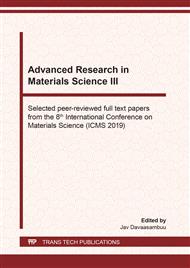p.47
p.53
p.58
p.65
p.81
p.88
p.96
p.101
p.109
Effects of Radio-Frequency Power and Deposition Pressure on Structures and Properties of Silicon-Rich Silicon Nitride Thin Films
Abstract:
Silicon-rich silicon nitride thin films have been grown by plasma enhanced chemical vapor deposition (PECVD) at 13.56MHZ on glass and N-type monocrystalline silicon substrate using high purity NH3,N2 and SiH4 as reactant gas sources by changing of radio-frequency (RF) power and deposition pressure. The samples were characterized by the ultraviolet-visible (UV-UIS) light transmittance spectra, Fourier transform infrared absorption spectroscopy (FTIR) and an X-ray (XRD) diffraction, respectively. The results showed that both the RF power and deposition pressure increase promote the deposition rates. However, the increase of rf power leads to the decrease of optical band gap, the increase of refractive index, and the increase of deposition pressure leads to the widening of optical band gap. The increase of rf power leads to the increase of the silicon atoms in the thin films and the transition of the films to the silicon-rich state. As the deposition pressure increase, the probability of N atoms entering the films increase and the thin films change to a nitrogen-rich state. At a certain pressure, when the rf power is changed, the average grain size in the films decrease by XRD analysis. Based on the above analysis, both the deposition pressure and rf power have an important effect on the microstructure, and optical properties of the thin films. By properly adjusting these two parameters, the silicon-rich silicon nitride films with good density can be obtained.
Info:
Periodical:
Pages:
81-87
Citation:
Online since:
September 2020
Authors:
Price:
Сopyright:
© 2020 Trans Tech Publications Ltd. All Rights Reserved
Share:
Citation:


